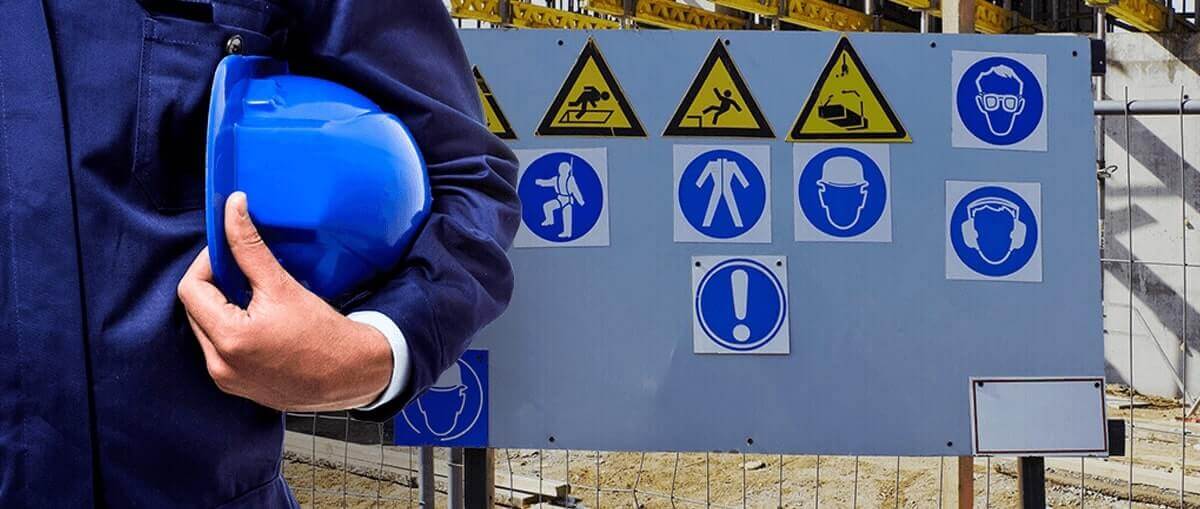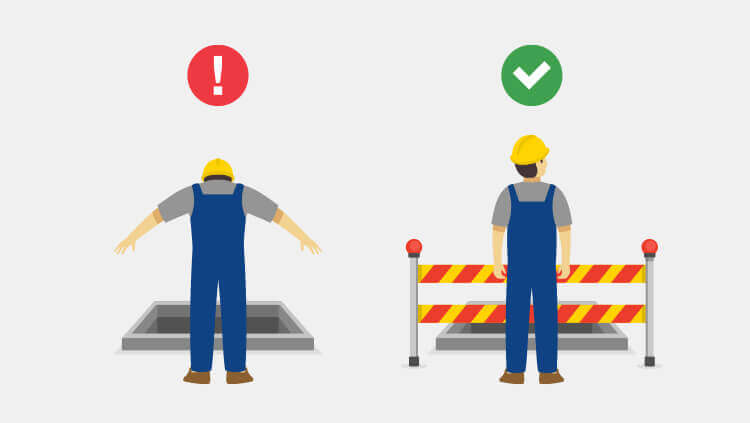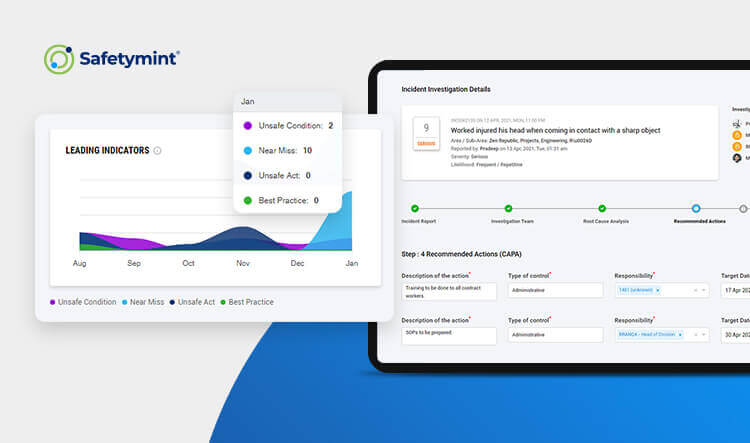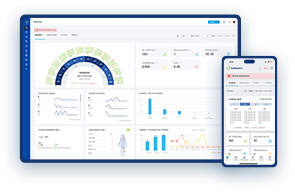
Top 20 Workplace Safety Tips
Workplace safety is a critical issue that affects the health, well-being, and productivity of employees. A safe work environment is essential for protecting employees from accidents, injuries, and health hazards, and for promoting a positive and productive workplace safety culture.
Effective workplace safety programs and use of safety management software is hence important to help employers create and maintain a safe and healthy work environment, which can result in lower costs, increased productivity, and a better reputation for the organization.
What is workplace safety?
By definition, workplace safety refers to the measures put in place to prevent accidents and injuries in the workplace. It involves creating a safe and healthy work environment that protects employees from harm and ensures that they can perform their duties without any undue risk to their health and wellbeing.
There are several key factors that contribute to a safe and healthy work environment. Some of the most important include:
Proper training: Employees must be properly trained on how to perform their jobs safely and how to use equipment and tools correctly.
Safe equipment: All equipment and tools must be regularly maintained and checked to ensure that they are in good working order.
Adequate lighting: Proper lighting is essential for a safe and healthy work environment, especially in areas where employees are working with heavy machinery or performing tasks that require precision.
Good housekeeping: Keeping the workplace clean and organized can help prevent accidents and injuries.
Proper ventilation: Adequate ventilation is necessary to prevent the buildup of hazardous substances and to provide a comfortable and healthy work environment.
Personal protective equipment: Employees must be provided with the appropriate Personal Protective Equipment (PPE) to protect them from harm while they are performing their duties.
Emergency response plans: Employers must have emergency response plans in place to ensure that employees know what to do in case of an emergency.
Related read: Our listing of the best Health and Safety Software.
Workplace injuries are surprisingly common, especially when you consider that they usually happen to people doing the same task day in and day out.
Most workplace accidents stem from unsafe working conditions, inadequately trained staff and negligence of the workers. This blog post will cover the 20 crucial workplace safety tips that you and your employees need to follow.
Top 20 workplace safety tips every employee should be aware of:
- Follow the Rules
- Wear Appropriate Safety Gear
- Be Mindful of Your Surroundings
- Use the Right Tools for the Job
- Put Away the Equipment After Each Use
- Dress Appropriately
- Report Unsafe Working Conditions
- Conduct Regular Safety Audits
- Stay Sober
- Keep Track of the Incidents
- Cultivate a Safety-First Workplace Culture
- Proactive Risk Assessment
- Emergency Evacuation Preparedness
- First Aid Readiness
- Empower Safety Committees
- Continuous Safety Training
- Proactive Near-Miss Reporting
- Harness the Power of Safety Data Analysis
- Holistic Occupational Health and Safety
- Safeguard Regulatory Compliance
Now, let us delve deeper on each of these safety tips.
1. Follow the Rules
Rules and regulations are there for a reason — to keep people safe.
If your workplace has a rule against talking on the phone while walking through a particular area or wearing additional protective gear for specific tasks, you need to follow it. By breaking the rule, you could put yourself or others in danger.
2. Wear Appropriate Safety Gear
While it might seem that essential protective equipment is only necessary when working on dangerous projects, wearing safety gear is important. This is because even small accidents can cause serious injury.
If a situation arises that requires you to use any power tools, you should be wearing appropriate safety gear like steel-toed boots, hard hats, and protective eyewear like goggles or face shields. There are many other similar situations where specific jobs require wearing additional PPE than the usual helmets.
3. Be Mindful of Your Surroundings
It is important to always be aware of what is going on around you at all times. This is important because distractions can cause injuries.
When you’re in an area with hazards or an ongoing job, be extra careful of the path and the things around you. It’s often best to turn off your cell phone so that you aren’t distracted by texts or calls. Also, make sure tools and machinery are not moving before you go near them and watch out for the work-in-progress signs before you step into an area.

4. Use the Right Tools for the Job
If you’re using a tool created for a different type of task, you could end up with an injury. The best way to avoid injury is to use machines, tools and equipment the right way. This includes:
- Using guards and other safety devices when they’re available
- Reading and following the instructions provided by the manufacturers of the tools and equipment
- Referring to the SOPs when choosing the tools for a job.
5. Put Away the Equipment After Each Use
This includes items such as extension cords, ladders and other tools. Having these items lying around can be dangerous for both you and your coworkers.
For example, tripping over an extension cord or ladder in the middle of a workday could lead to serious injuries. Laying out tools where others can’t see them could also create safety hazards since others may not realize those tools are there.
6. Dress Appropriately
Proper clothing can reduce workplace injuries and help you stay comfortable at the same time. This means wearing shoes and clothing that protect you from cuts, falls and slips, especially if you work near moving machinery or sharp objects or in high-risk areas like construction sites. Remember these basic rules:
- Never wear jewelry such as rings, bracelets or neck chains when working with machinery or power tools;
- Long hair must be tied back;
- Loose clothing must be secured;
- Clothes shouldn’t drag on the floor; and
- Pant legs should be tucked into boots.
7. Report Unsafe Working Conditions
If your job site is marked by broken equipment, hazardous materials or other potential dangers, report it to your employer. Also, don’t forget to report near-miss incidents as it could help your employers to create a better working space.
The Occupational Safety and Health Administration (OSHA) requires employers to maintain a safe work environment. When employees report violations of this law, OSHA can investigate and fine employers who aren’t in compliance.
8. Conduct Regular Safety Audits
Regular safety audits and site inspections can unveil much more than safety violations at your workplace. It can pave way for a culture where employee safety is given utmost priority. Including the right questions in your checklists will ensure you don’t miss any violations and also attain compliance.
9. Stay Sober
You may have a drink after work with friends or family or at an office party, but never drink or consume drugs before you work as it can impair you physically and mentally. You need to stay completely sober throughout the entire time you’re in the workplace to make sure that you’re completely in grips and aware of your environment.
10. Keep Track of the Incidents
If you want to prevent any more injuries, you need to investigate the safety incident reports. It can be severe incidents, near-misses or accidents. Analyzing the past few months’ or year’s reports will give you a better perspective into the common issues. You can also conduct a root-cause analysis to better understand the underlying reasons for the major incidents and accidents.

You can use an online incident management system to keep complete track of all incidents and conduct quick diagnosis and trend analysis.
11. Cultivate a Safety-First Workplace Culture
Fostering a strong safety culture is fundamental in any workplace. It’s about making safety a shared responsibility among all employees, where vigilance and accountability are ingrained. When safety becomes a part of the organizational DNA, it creates an environment where everyone looks out for one another, and safety practices are embraced naturally, contributing to a safer and more harmonious workplace.
12. Proactive Risk Assessment
Regular risk assessments are the cornerstone of a proactive safety strategy. By systematically assessing and identifying workplace hazards, you’re essentially practicing preventive safety measures. This approach enables the mitigation of potential risks before accidents occur, safeguarding your employees, your assets, and your business from harm and unnecessary disruptions.
13. Emergency Evacuation Preparedness
A well-defined emergency evacuation plan is the linchpin of workplace safety. It ensures that, in times of crisis, employees know precisely what to do, where to go, and how to respond. Regular evacuation drills further fortify readiness, making sure that employees can react swiftly and decisively in the face of an emergency, potentially saving lives and minimizing damage.
14. First Aid Readiness
First-aid kits and the knowledge of how to use them are essential assets in any workplace. These resources provide immediate care in the event of injuries, offering critical support until professional medical assistance arrives. Properly equipped and trained employees can make a vital difference in emergencies, enhancing safety and well-being across the workplace.
15. Empower Safety Committees
Safety committees serve as an invaluable platform for enhancing workplace safety. Comprising both management and employee representatives, they facilitate open dialogue about safety concerns, hazards, and potential improvements. By addressing safety issues collectively, these committees play a pivotal role in promoting and maintaining a safer, more secure work environment.
16. Continuous Safety Training
Ongoing safety training is the backbone of a vigilant and well-prepared workforce. It ensures that employees stay informed about the latest safety practices, procedures, and industry standards. This knowledge empowers them to work safely, take prompt actions during emergencies, and contribute to a culture of safety that transcends the workplace, enhancing overall well-being.
17. Proactive Near-Miss Reporting
Reporting near-miss incidents is not just a bureaucratic exercise; it’s a proactive approach to safety. These reports provide a unique window into potential safety issues that may otherwise go unnoticed. By addressing near-misses promptly, you can prevent accidents, injuries, and more significant safety issues, maintaining a safer and more secure work environment.
18. Harness the Power of Safety Data Analysis
Analyzing safety incident reports through safety KPI dashboards offer invaluable insights into workplace safety trends and areas for improvement. This process allows organizations to fine-tune their safety measures, making the workplace safer over time. By harnessing the power of data, you can proactively address safety concerns and continually enhance the well-being of your employees.
19. Holistic Occupational Health and Safety
Occupational health is a holistic approach to employee well-being. It extends beyond physical safety, encompassing mental, emotional, and overall health in the workplace. Monitoring and addressing occupational health concerns ensure that employees are not only safe from physical hazards but also enjoy a positive and nurturing work environment that supports their overall well-being.
20. Safeguard Regulatory Compliance
Maintaining regulatory compliance is a critical aspect of workplace safety. Safety standards and regulations may vary by industry, making it imperative to stay informed and ensure that your workplace adheres to all relevant safety standards and laws. Being compliant not only enhances safety but also protects your organization from potential legal and financial risks.
Also read our detailed guide on how to write an incident report.

Ramesh Nair is the Founder and Principal Partner of Niyati Technologies, the company behind Safetymint.
He’s a dedicated advocate for workplace safety. Ramesh firmly believes that every individual deserves to return home safely after a day’s work. Safetymint, the innovative safety management software, emerged from this conviction. It’s a platform designed to streamline safety management, empower safety professionals, and enhance safety in workplaces.
Through his blog, Ramesh shares insights, best practices, and innovative solutions for workplace safety. Visit his social media profiles to follow him for regular updates.




